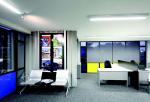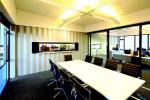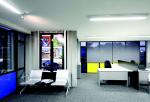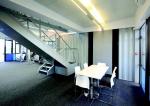Innovation
Royal Wolf offices. A new benchmark in container design and construction
It’s fitting a company specialising in shipping containers has an office made out of the product it knows best.
And when Royal Wolf, Australasia’s biggest provider of shipping containers, was looking to build its new offices in Auckland it was two 40-foot and six 20-foot containers that were modified to become the centre-piece of its East Tamaki operation.
Architect Frank Tonetti, of Devonport based Architettura, was chosen to design the offices because of his innovative work with container building solutions, ranging from single and multi-storey residential “modules” to “emergency houses” for aid projects.
His brief from Royal Wolf was to create offices that showcase the company’s modification expertise, innovative and expressive container construction, and, most importantly, the functional and efficient space it has created for Royal Wolf's administration centre.
Mr Tonetti initially made a cardboard box model of his proposal and from that Royal Wolf was sold on the idea.
“The challenge though,” he says, “was to demonstrate the versatility of containerised building solutions, stepping beyond the usual conventional stacking method that is most common.”
“The hybrid building solution offers a unique container aesthetic. There are offices and service spaces that require privacy occupying the containers themselves, and the larger spaces between containers provide versatile open plan reception, retail and boardroom facilities.
“It’s all about the spaces between, around, and under the containers. The diverse orientation, stacking and cantilevering of different sized containers in combination with fully glazed voids and spaces between containers creating interesting architecture - an inter-play of solidity and transparency."
Mr Tonetti says essential to the office project is the Metalcraft insulated panels and the pre-finished COLORSTEEL® external metal.
He says the beauty of the Metalcraft panels is that they can span long distances yet are lightweight which saves on installation costs and assembly time.
“They have performed admirably and they provide excellent building insulation to walls, roof and floor because it eliminates concerns around ‘thermal bridging’ that is normally associated with traditional construction.”
Meanwhile, the COLORSTEEL® skin, which provides a durable and attractive roof finish and internal ceiling finish, is particularly suitable for commercial building applications, he says.
Mr Tonetti believes further development of insulated panel construction by the likes of Metalcraft should be encouraged because they have a crucial role to play in residential buildings of the future.
“These products have a long and successful construction history in New Zealand already, but now with the advent of new improved PIR core options, and enhanced metal skin coatings and pattern profile options, there is an excellent opportunity to utilise these systems in residential construction.
“This is an area where New Zealand is desperately looking for alternative and affordable prefabricated solution to replace outdated traditional construction systems.”
Mr Tonetti says containers, which are made from high grade Corten A steel, are also a valuable alternative to traditional construction because they are portable, robust and in terms of sustainability they are unbeatable.
“For longevity containers cannot be matched. In terms of earthquake resistance they significantly exceed NZ Building Code earthquake requirements and the best thing is that they are supplied like this.”
Mr Tonetti’s company Architettura has more than 30 years experience in commercial, institutional and residential architecture in both New Zealand and southern Africa.
More recently however the company has placed a renewed focus on community and aid projects.
His design philosophy these days is strongly influenced by his passion for aid work and his belief container solutions out-perform and out-live conventional construction systems.
With this in mind Architettura has developed a system for transportable building structures to respond to emergencies in cyclone and earthquake prone areas, and for deployment to inhospitable areas.
The Icon system uses a full range of connected Royal Wolf shipping containers with unique layout design to overcome spatial limitations and offer generous open plan spaces between containers. It also utilises cantilevered floor and roof beams which span between containers, and long span ISP floor and roof panels means construction set up is quick and relatively easy.
“The system has significant structural durability, thermal performance and weather tightness advantages which out-perform conventional construction systems and more than meet Building Code requirements.
“Custom pre-fitted out containers could be ready and off to Tonga in a day and then be operational almost immediately once it makes it to its destination. The ability to do that is remarkable rather than the costly and slow method of dropping partially framed structures that need to wait for specialised tradesmen to be assembled on site.
“In these sorts of disaster environments containers easily outperform timber constructions. If you want a building that’s instant, robust and will perform in a remote location or harsh environment then this is it.”





